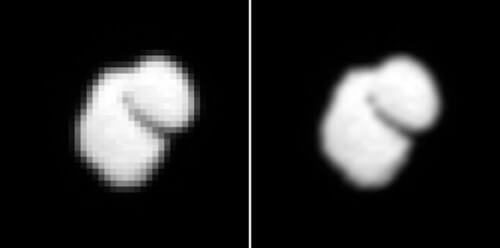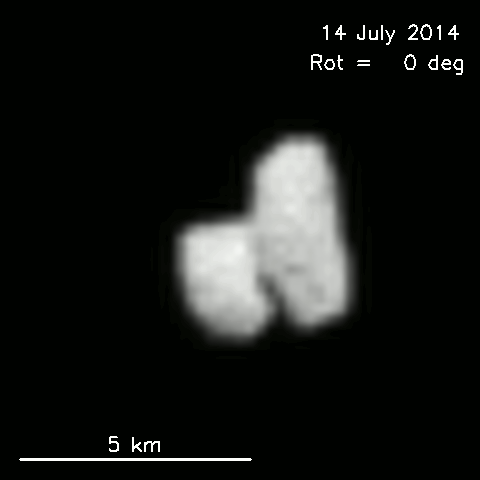It is possible that the comet is actually a double comet consisting of two separate comets or two parts of a larger comet that broke up, when the two fragments stuck together during a low-speed collision.

The short video at the bottom of this article, consisting of 36 processed images of Comet 67P/CG, shows the complex shape of the comet as the Rosetta spacecraft approaches its target. Some claim that it looks like a duck, others compare it to a baby's leg. The original images used for the animation were much more blurred, but a technique known as "sub-sampling by interpolation" was used to smooth out the pixels and give the image a more natural look.
No one knows how this strange shape came to be in the first place. It is possible that the comet is actually a double comet consisting of two separate comets or two parts of a larger comet that broke up, when the two fragments stuck together during a low-speed collision. This may have occurred over 4 billion years ago when the building blocks of planets and comets were numerous and collisions were much more frequent than today. Double comets touching each other are quite common, as are asteroids.
Another possibility is that the comet was once a much more spherical object but after many trips near the Sun it wore down to an asymmetrical shape after the ice and gas evaporated.
Other possibilities are that a huge collision caused a significant chunk of the comet's ice to be torn off, or that the object experienced a strong pull during its approach to a large planet such as Jupiter or Saturn that pulled it and caused its strange shape. Another possibility is that a large eruption weakened the area on the surface which later slowly disintegrated.
"We will be required to perform a detailed analysis and modeling of the comet's shape to determine the best way to fly around this uniquely shaped object, for the benefit of flight controllers and astrodynamics, and the components related to landing such as analysis of the landing site and the field of view between the lander and the dashpot," said Rosetta Mission Manager Fred Jensen , "but we will have to do this only after the spacecraft approaches the direction of the comet to a distance of less than 10,000 km - not before August 6."
As it approaches a distance that will allow for clearer photography, the spacecraft will circle the comet for two months and on November 11 it is scheduled to make a soft landing on the Philae spacecraft. This will be the first planned soft landing on a comet. Given the low gravity of a comet nucleus that is about 4 kilometers in diameter, Philae will be required to use ice screwdrivers and bells to stop it from flying back into space after touching down.

For information on the Universe Today website
More on the subject on the science website

5 תגובות
Thanks!
Batya
As far as I know - there are such devices. They work based on sound waves.
These devices know how to map the terrain route.
Why aren't they used in the 'Tzuk Eitan' operation - I don't know.
On the other hand, it is possible that these devices are being used (and maybe even sophisticated ones), but we don't know about it. )
A question that the younger generation in the family asked me (not related to the topic of the article) and maybe someone here has an answer: how is it that there are no devices with which you can check what is happening underground, that you can at least see if there is a tunnel or not. According to him he saw something in a movie about exploring caves that you can tell there is an empty space, so why isn't it used in the military?
I will thank anyone who can give a sensible answer or refer me to an article on the subject (also possible in English).